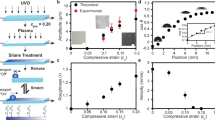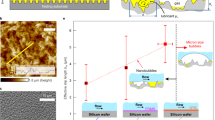Abstract
Entrapment of small air bubbles is a problem for continuous liquid-film coatings processes. The coating of any surface requires that the surrounding air in contact with it be displaced by an advancing liquid interface. Studies of dynamic wetting suggest that if the interface motion is too rapid, the air is not completely removed and it becomes entrained in the coating material1. This process, which can lead to undesirable flaws in the form of bubbles, blemishes or voids, limits the speed at which the substrate can be moved in the production of uniform precision coatings. However, the entrapment process is not understood in detail. Here we report an experimental investigation of air entrapment in high-speed coating operations. Tip streaming—a phenomenon well known in emulsification technology2, involving the ejection of a fine filament from the cusped interface between two immiscible fluids—is shown to be the precursor of air entrainment. We demonstrate that tip-streaming air filaments emanating from the contact zone of a dynamic liquid interface give rise to minute (∼10 µm) bubbles.
This is a preview of subscription content, access via your institution
Access options
Subscribe to this journal
Receive 51 print issues and online access
$199.00 per year
only $3.90 per issue
Buy this article
- Purchase on Springer Link
- Instant access to full article PDF
Prices may be subject to local taxes which are calculated during checkout




Similar content being viewed by others
References
Benjamin, D. F. et al. Coating flows: form and function. Indust. Coating Res. 1, 1–37 (1991).
Grace, H. P. Dispersion phenomena in high viscosity immiscible fluid systems and the application of static mixers as dispersion devices in such systems. Chem. Eng. Commun. 14, 225–277 (1982).
Kistler, S. F. in Wettability (ed. Berg, J. C.) 311–429 (Marcel Dekker, New York, 1993).
Blake, T. D. & Ruschak, K. J. A maximum speed of wetting. Nature 282, 489–491 (1979).
Bolton, B. & Middleman, S. Air entrainment in a roll coating system. Chem. Eng. Sci. 35, 597–601 (1980).
Ghannam, M. T. & Esmail, M. N. Effect of substrate entry angle on air entrainment in liquid coating. Am. Inst. Chem. Engrs J. 36, 1283–86 (1990).
Jeong, J. -T. & Moffatt, H. K. Free-surface cusps associated with flow at low Reynolds numbers. J. Fluid Mech. 241, 1–22 (1992).
Joseph, D. D., Nelson, J., Renardy, M. & Renardy, Y. Two-dimensional cusped interfaces. J. Fluid Mech. 223, 383–409 (1991).
Taylor, G. I. The formation of emulsions in definable fields of flow. Proc. R. Soc. Lond. A 146, 501–523 (1934).
Dussan, V. E. B. & Davis, S. H. On the motion of a fluid–fluid interface along a solid surface. J. Fluid Mech. 65, 71–95 (1974).
Pozrikidis, C. Numerical studies of cusp formation at fluid interfaces in Stokes flow. J. Fluid Mech. 357, 29–57 (1998).
Shiikhmurzaev, Y. D. On cusped interfaces. J. Fluid Mech 359, 313–328 (1998).
Sherwood, J. D. Tip streaming from slender drops in a nonlinear extensional flow. J. Fluid Mech. 144, 281–295 (1984).
Smith, P. G. & Van de Ven, T. G. M. Shear induced deformation and rupture of suspended solid/liquid clusters. Colloids Surf. 15, 191–210 (1985).
Stone, H. A. Dynamics of drop deformation and breakup in viscous fluids. Annu. Rev. Fluid Mech. 26, 65–102 (1994).
Eggers, J. Nonlinear dynamics and breakup of free-surface flows. Rev. Mod. Phys. 69, 865–929 (1997).
de Bruijn, R. A. Tip streaming of drops in simple shear flows. Chem. Eng. Sci. 48, 277–284 (1993).
Siegal, M. Influence of surfactant on rounded and pointed bubbles in 2-D Stokes flow. SIAM J. Appl. Math. 59, 1998–2007 (1999).
Author information
Authors and Affiliations
Corresponding author
Rights and permissions
About this article
Cite this article
Simpkins, P., Kuck, V. Air entrapment in coatings by way of a tip-streaming meniscus. Nature 403, 641–643 (2000). https://doi.org/10.1038/35001043
Received:
Accepted:
Issue Date:
DOI: https://doi.org/10.1038/35001043
This article is cited by
-
On the impact of viscous drops onto dry smooth surfaces
Experiments in Fluids (2012)
Comments
By submitting a comment you agree to abide by our Terms and Community Guidelines. If you find something abusive or that does not comply with our terms or guidelines please flag it as inappropriate.



